Critical Review of Ontario's Policy on Building Retirement Security
VerifiedAdded on 2020/05/11
|14
|4305
|190
Report
AI Summary
This report provides a critical analysis of the Ontario Retirement Security Policy document, focusing on the Ontario Retirement Pension Plan and its impact on the retirement security of Ontario workers. The analysis examines the policy's objectives, including strengthening retirement security for workers, especially those without sufficient workplace pension plans. It outlines the advantages and disadvantages of the Ontario Retirement Pension Plan, including retirement and survivor benefits, and how it aims to provide income replacement. The report also delves into different types of pension plans, such as defined benefit (DB), defined contribution (DC), hybrid plans, group Registered Retirement Savings Plans, and Deferred Profit-Sharing Plans, comparing their features, benefits, and implications for employers and employees. The analysis considers the role of government, private providers, and individuals in ensuring retirement readiness and the sustainability of retirement income. Various legislative requirements regarding the plan, including participation, contributions, and benefits are also discussed.
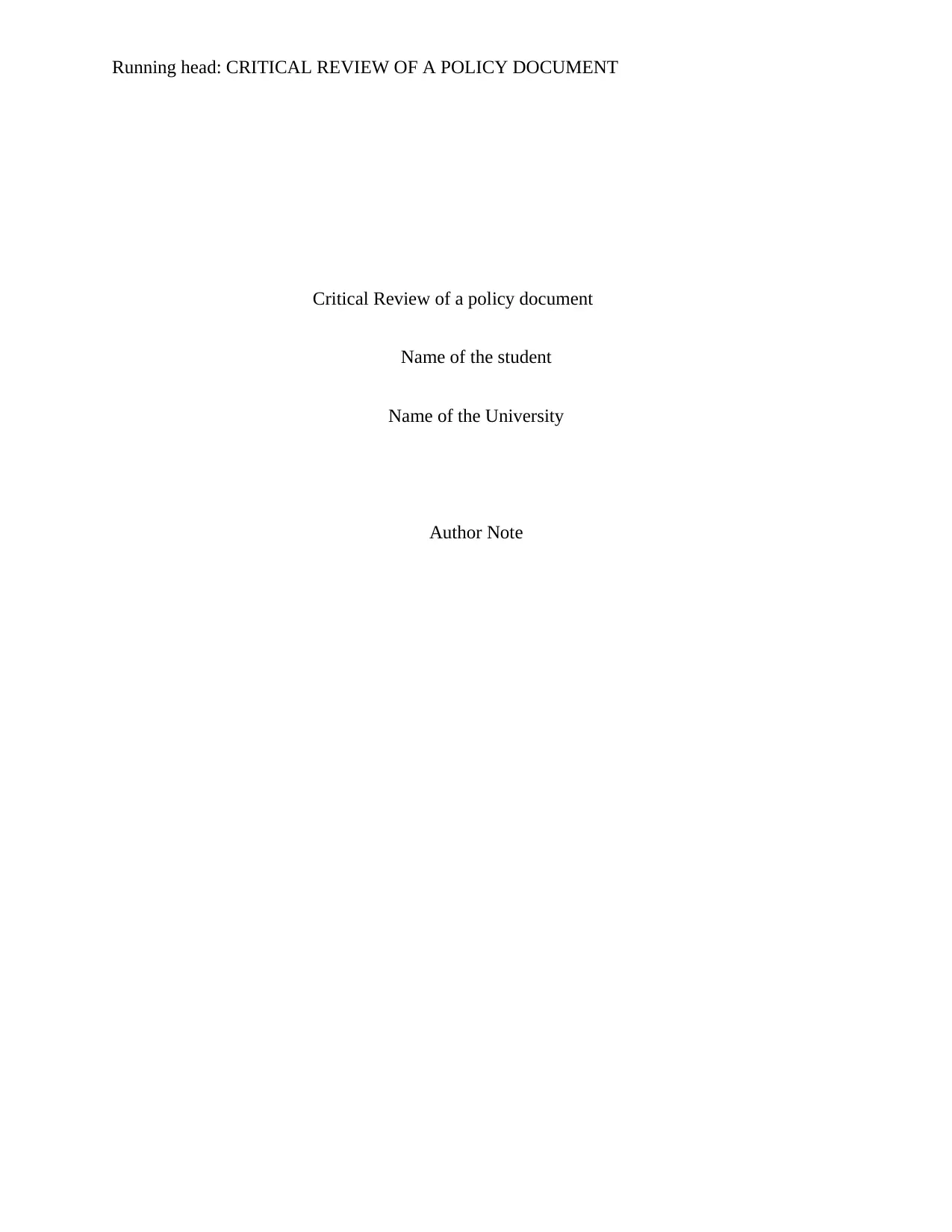
Running head: CRITICAL REVIEW OF A POLICY DOCUMENT
Critical Review of a policy document
Name of the student
Name of the University
Author Note
Critical Review of a policy document
Name of the student
Name of the University
Author Note
Paraphrase This Document
Need a fresh take? Get an instant paraphrase of this document with our AI Paraphraser
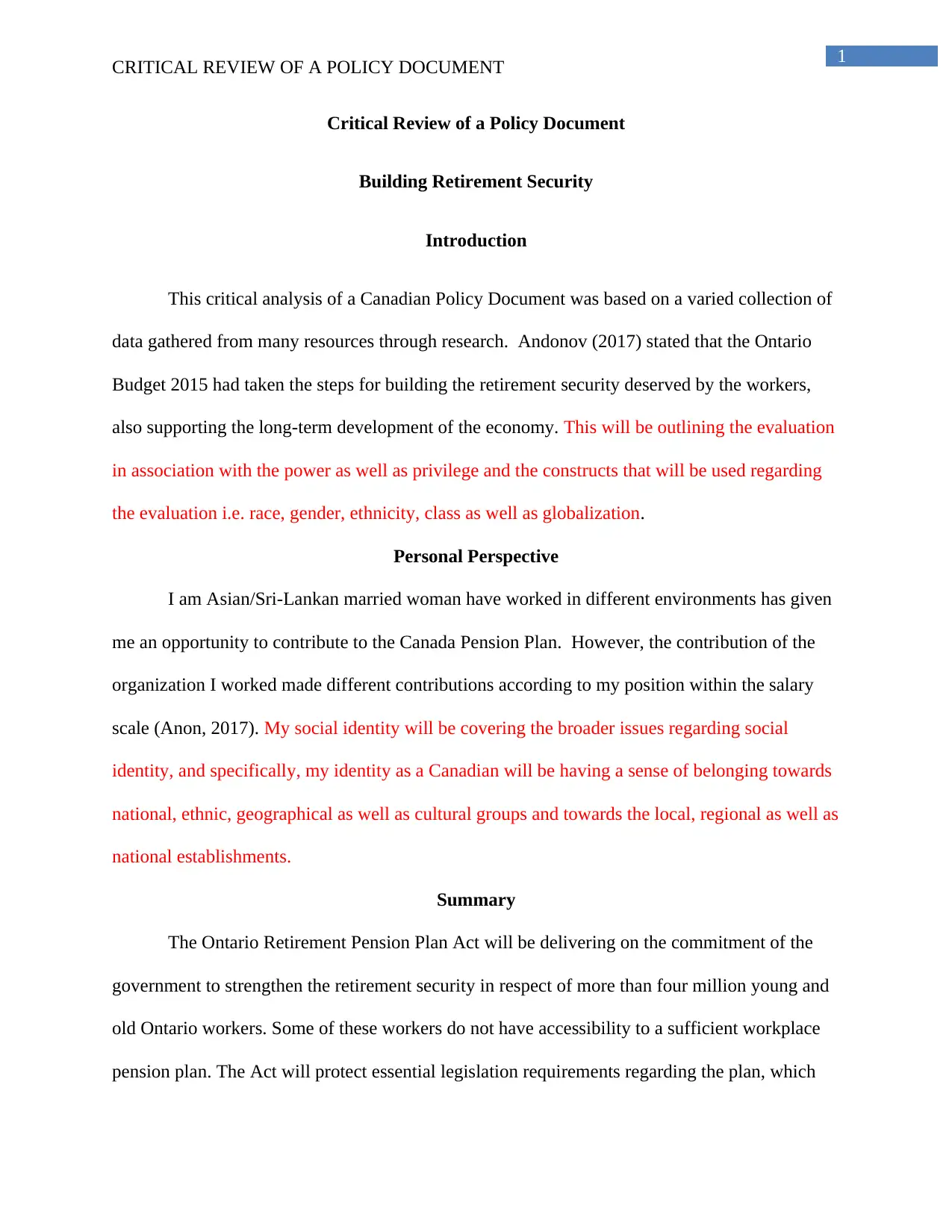
1
CRITICAL REVIEW OF A POLICY DOCUMENT
Critical Review of a Policy Document
Building Retirement Security
Introduction
This critical analysis of a Canadian Policy Document was based on a varied collection of
data gathered from many resources through research. Andonov (2017) stated that the Ontario
Budget 2015 had taken the steps for building the retirement security deserved by the workers,
also supporting the long-term development of the economy. This will be outlining the evaluation
in association with the power as well as privilege and the constructs that will be used regarding
the evaluation i.e. race, gender, ethnicity, class as well as globalization.
Personal Perspective
I am Asian/Sri-Lankan married woman have worked in different environments has given
me an opportunity to contribute to the Canada Pension Plan. However, the contribution of the
organization I worked made different contributions according to my position within the salary
scale (Anon, 2017). My social identity will be covering the broader issues regarding social
identity, and specifically, my identity as a Canadian will be having a sense of belonging towards
national, ethnic, geographical as well as cultural groups and towards the local, regional as well as
national establishments.
Summary
The Ontario Retirement Pension Plan Act will be delivering on the commitment of the
government to strengthen the retirement security in respect of more than four million young and
old Ontario workers. Some of these workers do not have accessibility to a sufficient workplace
pension plan. The Act will protect essential legislation requirements regarding the plan, which
CRITICAL REVIEW OF A POLICY DOCUMENT
Critical Review of a Policy Document
Building Retirement Security
Introduction
This critical analysis of a Canadian Policy Document was based on a varied collection of
data gathered from many resources through research. Andonov (2017) stated that the Ontario
Budget 2015 had taken the steps for building the retirement security deserved by the workers,
also supporting the long-term development of the economy. This will be outlining the evaluation
in association with the power as well as privilege and the constructs that will be used regarding
the evaluation i.e. race, gender, ethnicity, class as well as globalization.
Personal Perspective
I am Asian/Sri-Lankan married woman have worked in different environments has given
me an opportunity to contribute to the Canada Pension Plan. However, the contribution of the
organization I worked made different contributions according to my position within the salary
scale (Anon, 2017). My social identity will be covering the broader issues regarding social
identity, and specifically, my identity as a Canadian will be having a sense of belonging towards
national, ethnic, geographical as well as cultural groups and towards the local, regional as well as
national establishments.
Summary
The Ontario Retirement Pension Plan Act will be delivering on the commitment of the
government to strengthen the retirement security in respect of more than four million young and
old Ontario workers. Some of these workers do not have accessibility to a sufficient workplace
pension plan. The Act will protect essential legislation requirements regarding the plan, which
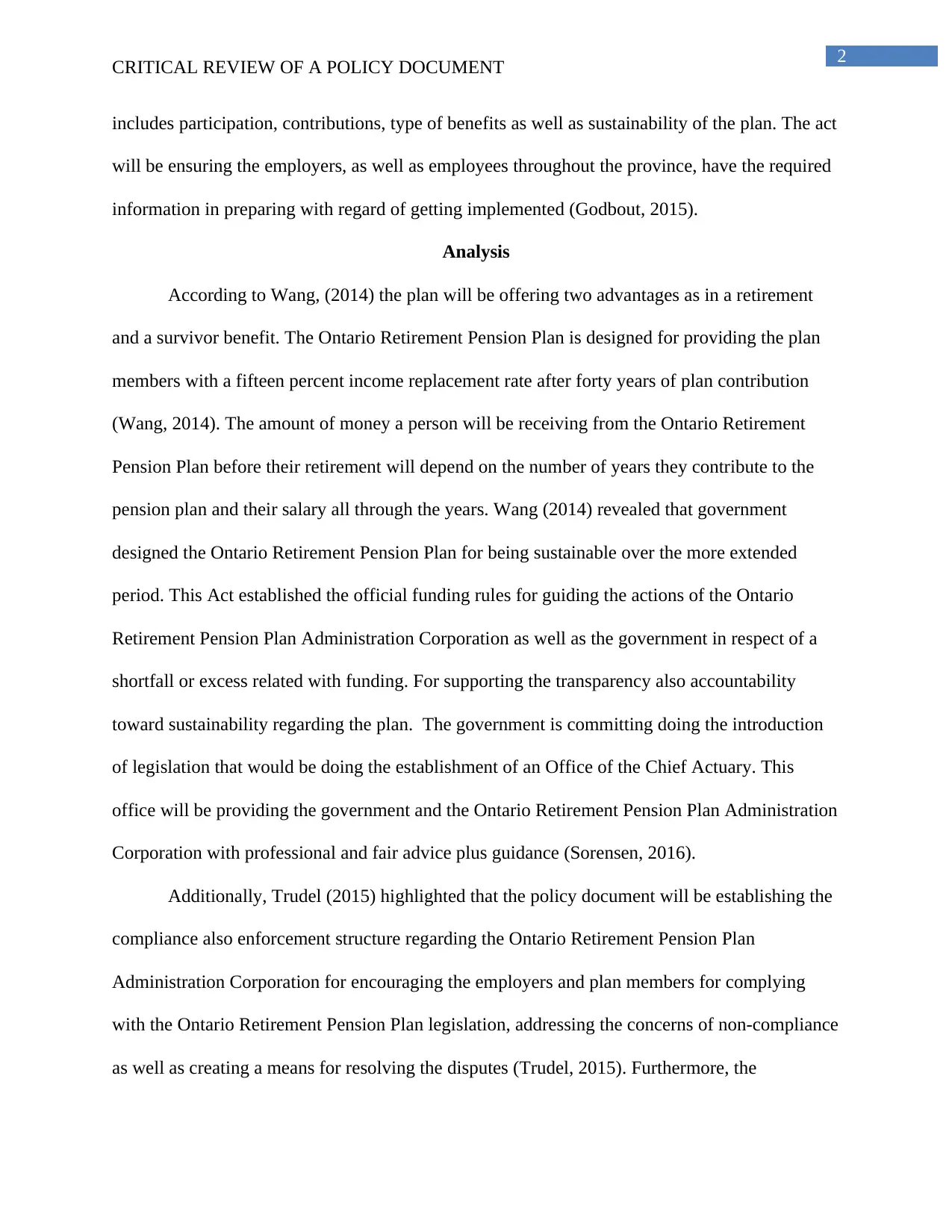
2
CRITICAL REVIEW OF A POLICY DOCUMENT
includes participation, contributions, type of benefits as well as sustainability of the plan. The act
will be ensuring the employers, as well as employees throughout the province, have the required
information in preparing with regard of getting implemented (Godbout, 2015).
Analysis
According to Wang, (2014) the plan will be offering two advantages as in a retirement
and a survivor benefit. The Ontario Retirement Pension Plan is designed for providing the plan
members with a fifteen percent income replacement rate after forty years of plan contribution
(Wang, 2014). The amount of money a person will be receiving from the Ontario Retirement
Pension Plan before their retirement will depend on the number of years they contribute to the
pension plan and their salary all through the years. Wang (2014) revealed that government
designed the Ontario Retirement Pension Plan for being sustainable over the more extended
period. This Act established the official funding rules for guiding the actions of the Ontario
Retirement Pension Plan Administration Corporation as well as the government in respect of a
shortfall or excess related with funding. For supporting the transparency also accountability
toward sustainability regarding the plan. The government is committing doing the introduction
of legislation that would be doing the establishment of an Office of the Chief Actuary. This
office will be providing the government and the Ontario Retirement Pension Plan Administration
Corporation with professional and fair advice plus guidance (Sorensen, 2016).
Additionally, Trudel (2015) highlighted that the policy document will be establishing the
compliance also enforcement structure regarding the Ontario Retirement Pension Plan
Administration Corporation for encouraging the employers and plan members for complying
with the Ontario Retirement Pension Plan legislation, addressing the concerns of non-compliance
as well as creating a means for resolving the disputes (Trudel, 2015). Furthermore, the
CRITICAL REVIEW OF A POLICY DOCUMENT
includes participation, contributions, type of benefits as well as sustainability of the plan. The act
will be ensuring the employers, as well as employees throughout the province, have the required
information in preparing with regard of getting implemented (Godbout, 2015).
Analysis
According to Wang, (2014) the plan will be offering two advantages as in a retirement
and a survivor benefit. The Ontario Retirement Pension Plan is designed for providing the plan
members with a fifteen percent income replacement rate after forty years of plan contribution
(Wang, 2014). The amount of money a person will be receiving from the Ontario Retirement
Pension Plan before their retirement will depend on the number of years they contribute to the
pension plan and their salary all through the years. Wang (2014) revealed that government
designed the Ontario Retirement Pension Plan for being sustainable over the more extended
period. This Act established the official funding rules for guiding the actions of the Ontario
Retirement Pension Plan Administration Corporation as well as the government in respect of a
shortfall or excess related with funding. For supporting the transparency also accountability
toward sustainability regarding the plan. The government is committing doing the introduction
of legislation that would be doing the establishment of an Office of the Chief Actuary. This
office will be providing the government and the Ontario Retirement Pension Plan Administration
Corporation with professional and fair advice plus guidance (Sorensen, 2016).
Additionally, Trudel (2015) highlighted that the policy document will be establishing the
compliance also enforcement structure regarding the Ontario Retirement Pension Plan
Administration Corporation for encouraging the employers and plan members for complying
with the Ontario Retirement Pension Plan legislation, addressing the concerns of non-compliance
as well as creating a means for resolving the disputes (Trudel, 2015). Furthermore, the
⊘ This is a preview!⊘
Do you want full access?
Subscribe today to unlock all pages.

Trusted by 1+ million students worldwide
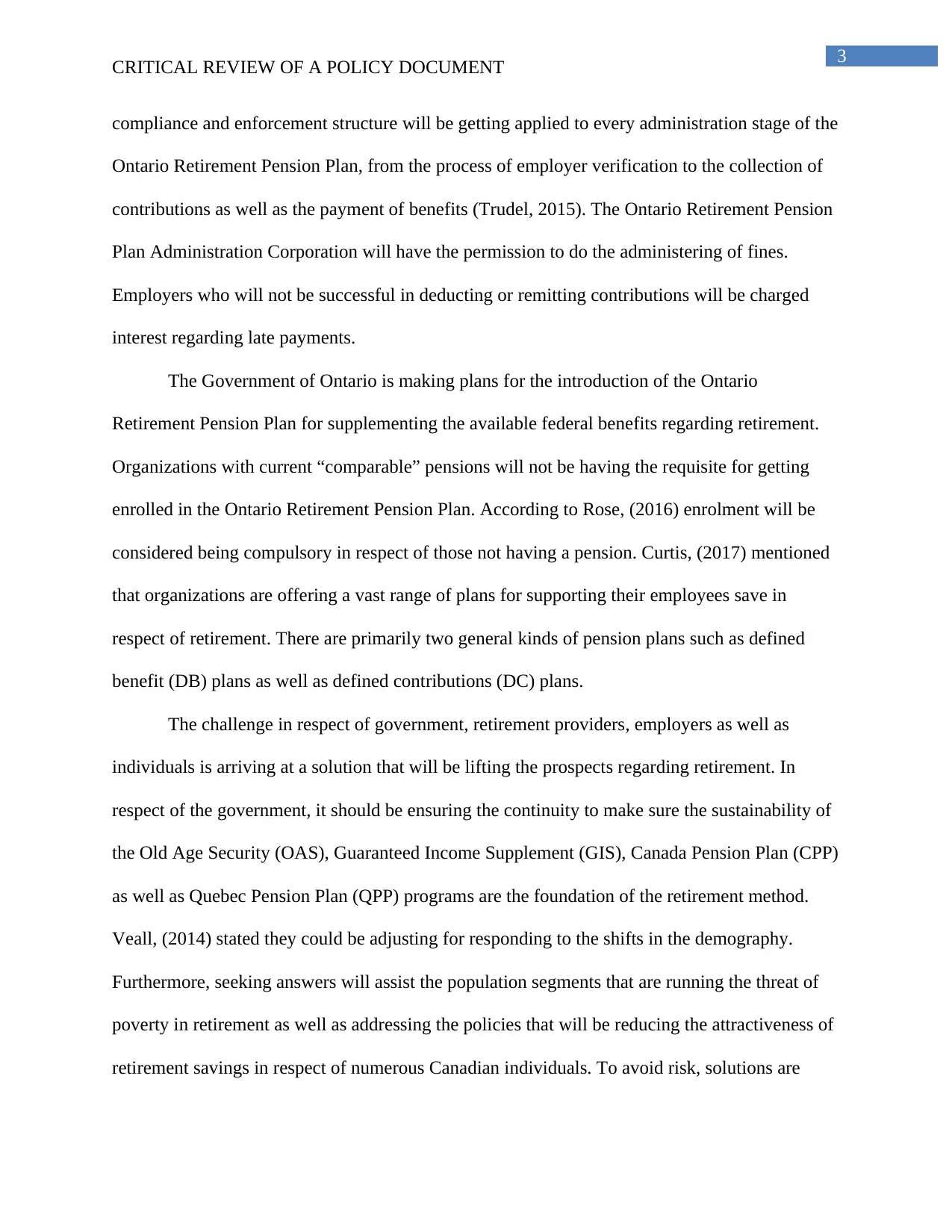
3
CRITICAL REVIEW OF A POLICY DOCUMENT
compliance and enforcement structure will be getting applied to every administration stage of the
Ontario Retirement Pension Plan, from the process of employer verification to the collection of
contributions as well as the payment of benefits (Trudel, 2015). The Ontario Retirement Pension
Plan Administration Corporation will have the permission to do the administering of fines.
Employers who will not be successful in deducting or remitting contributions will be charged
interest regarding late payments.
The Government of Ontario is making plans for the introduction of the Ontario
Retirement Pension Plan for supplementing the available federal benefits regarding retirement.
Organizations with current “comparable” pensions will not be having the requisite for getting
enrolled in the Ontario Retirement Pension Plan. According to Rose, (2016) enrolment will be
considered being compulsory in respect of those not having a pension. Curtis, (2017) mentioned
that organizations are offering a vast range of plans for supporting their employees save in
respect of retirement. There are primarily two general kinds of pension plans such as defined
benefit (DB) plans as well as defined contributions (DC) plans.
The challenge in respect of government, retirement providers, employers as well as
individuals is arriving at a solution that will be lifting the prospects regarding retirement. In
respect of the government, it should be ensuring the continuity to make sure the sustainability of
the Old Age Security (OAS), Guaranteed Income Supplement (GIS), Canada Pension Plan (CPP)
as well as Quebec Pension Plan (QPP) programs are the foundation of the retirement method.
Veall, (2014) stated they could be adjusting for responding to the shifts in the demography.
Furthermore, seeking answers will assist the population segments that are running the threat of
poverty in retirement as well as addressing the policies that will be reducing the attractiveness of
retirement savings in respect of numerous Canadian individuals. To avoid risk, solutions are
CRITICAL REVIEW OF A POLICY DOCUMENT
compliance and enforcement structure will be getting applied to every administration stage of the
Ontario Retirement Pension Plan, from the process of employer verification to the collection of
contributions as well as the payment of benefits (Trudel, 2015). The Ontario Retirement Pension
Plan Administration Corporation will have the permission to do the administering of fines.
Employers who will not be successful in deducting or remitting contributions will be charged
interest regarding late payments.
The Government of Ontario is making plans for the introduction of the Ontario
Retirement Pension Plan for supplementing the available federal benefits regarding retirement.
Organizations with current “comparable” pensions will not be having the requisite for getting
enrolled in the Ontario Retirement Pension Plan. According to Rose, (2016) enrolment will be
considered being compulsory in respect of those not having a pension. Curtis, (2017) mentioned
that organizations are offering a vast range of plans for supporting their employees save in
respect of retirement. There are primarily two general kinds of pension plans such as defined
benefit (DB) plans as well as defined contributions (DC) plans.
The challenge in respect of government, retirement providers, employers as well as
individuals is arriving at a solution that will be lifting the prospects regarding retirement. In
respect of the government, it should be ensuring the continuity to make sure the sustainability of
the Old Age Security (OAS), Guaranteed Income Supplement (GIS), Canada Pension Plan (CPP)
as well as Quebec Pension Plan (QPP) programs are the foundation of the retirement method.
Veall, (2014) stated they could be adjusting for responding to the shifts in the demography.
Furthermore, seeking answers will assist the population segments that are running the threat of
poverty in retirement as well as addressing the policies that will be reducing the attractiveness of
retirement savings in respect of numerous Canadian individuals. To avoid risk, solutions are
Paraphrase This Document
Need a fresh take? Get an instant paraphrase of this document with our AI Paraphraser
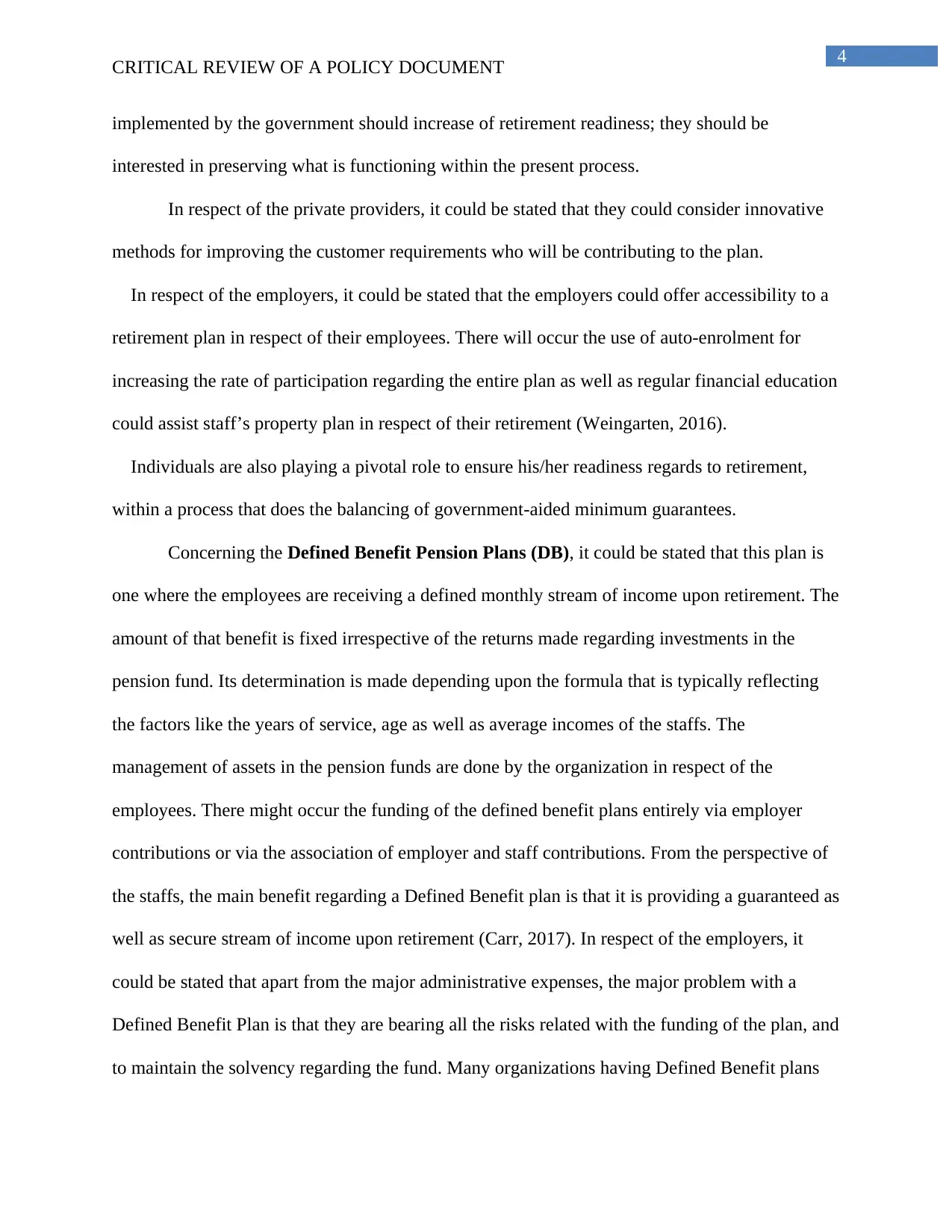
4
CRITICAL REVIEW OF A POLICY DOCUMENT
implemented by the government should increase of retirement readiness; they should be
interested in preserving what is functioning within the present process.
In respect of the private providers, it could be stated that they could consider innovative
methods for improving the customer requirements who will be contributing to the plan.
In respect of the employers, it could be stated that the employers could offer accessibility to a
retirement plan in respect of their employees. There will occur the use of auto-enrolment for
increasing the rate of participation regarding the entire plan as well as regular financial education
could assist staff’s property plan in respect of their retirement (Weingarten, 2016).
Individuals are also playing a pivotal role to ensure his/her readiness regards to retirement,
within a process that does the balancing of government-aided minimum guarantees.
Concerning the Defined Benefit Pension Plans (DB), it could be stated that this plan is
one where the employees are receiving a defined monthly stream of income upon retirement. The
amount of that benefit is fixed irrespective of the returns made regarding investments in the
pension fund. Its determination is made depending upon the formula that is typically reflecting
the factors like the years of service, age as well as average incomes of the staffs. The
management of assets in the pension funds are done by the organization in respect of the
employees. There might occur the funding of the defined benefit plans entirely via employer
contributions or via the association of employer and staff contributions. From the perspective of
the staffs, the main benefit regarding a Defined Benefit plan is that it is providing a guaranteed as
well as secure stream of income upon retirement (Carr, 2017). In respect of the employers, it
could be stated that apart from the major administrative expenses, the major problem with a
Defined Benefit Plan is that they are bearing all the risks related with the funding of the plan, and
to maintain the solvency regarding the fund. Many organizations having Defined Benefit plans
CRITICAL REVIEW OF A POLICY DOCUMENT
implemented by the government should increase of retirement readiness; they should be
interested in preserving what is functioning within the present process.
In respect of the private providers, it could be stated that they could consider innovative
methods for improving the customer requirements who will be contributing to the plan.
In respect of the employers, it could be stated that the employers could offer accessibility to a
retirement plan in respect of their employees. There will occur the use of auto-enrolment for
increasing the rate of participation regarding the entire plan as well as regular financial education
could assist staff’s property plan in respect of their retirement (Weingarten, 2016).
Individuals are also playing a pivotal role to ensure his/her readiness regards to retirement,
within a process that does the balancing of government-aided minimum guarantees.
Concerning the Defined Benefit Pension Plans (DB), it could be stated that this plan is
one where the employees are receiving a defined monthly stream of income upon retirement. The
amount of that benefit is fixed irrespective of the returns made regarding investments in the
pension fund. Its determination is made depending upon the formula that is typically reflecting
the factors like the years of service, age as well as average incomes of the staffs. The
management of assets in the pension funds are done by the organization in respect of the
employees. There might occur the funding of the defined benefit plans entirely via employer
contributions or via the association of employer and staff contributions. From the perspective of
the staffs, the main benefit regarding a Defined Benefit plan is that it is providing a guaranteed as
well as secure stream of income upon retirement (Carr, 2017). In respect of the employers, it
could be stated that apart from the major administrative expenses, the major problem with a
Defined Benefit Plan is that they are bearing all the risks related with the funding of the plan, and
to maintain the solvency regarding the fund. Many organizations having Defined Benefit plans
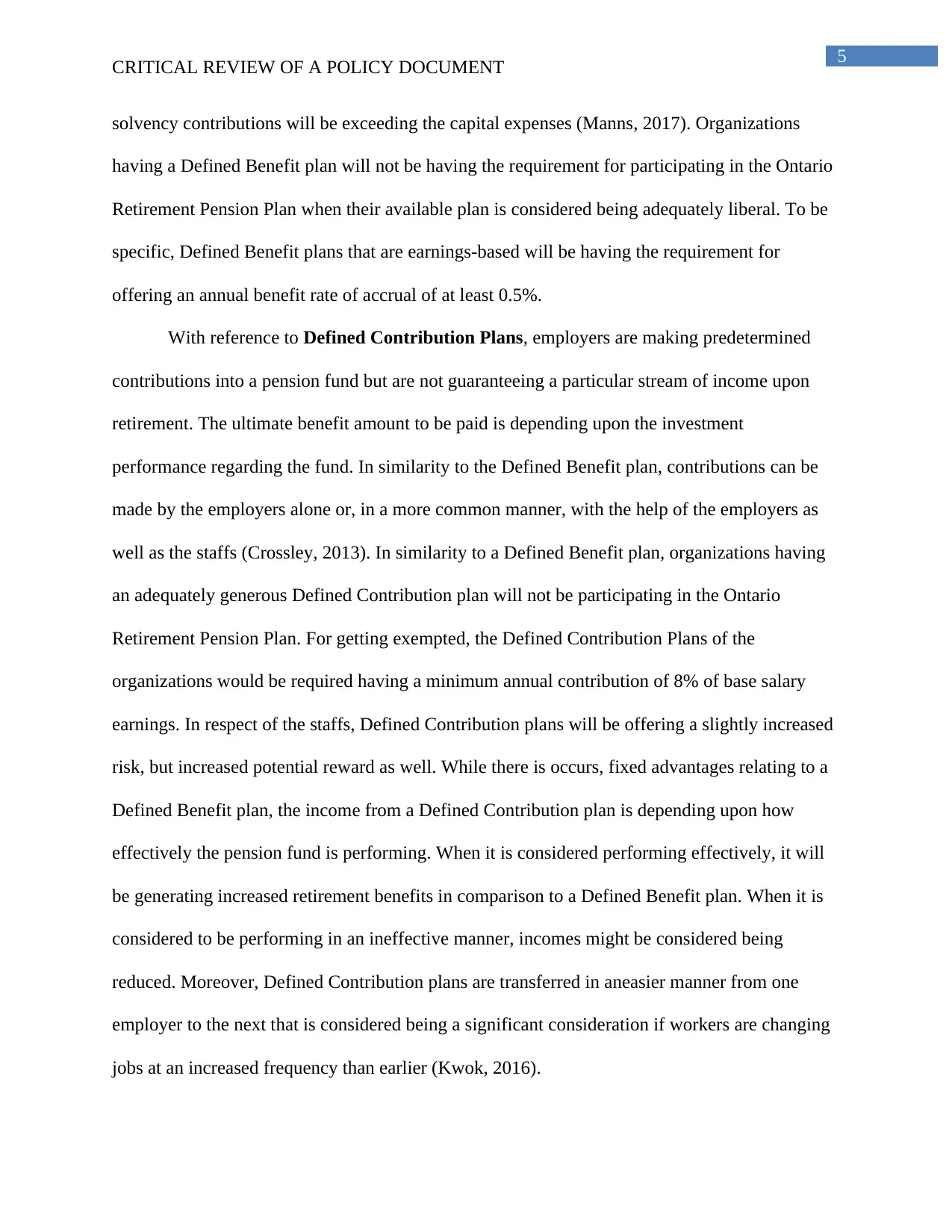
5
CRITICAL REVIEW OF A POLICY DOCUMENT
solvency contributions will be exceeding the capital expenses (Manns, 2017). Organizations
having a Defined Benefit plan will not be having the requirement for participating in the Ontario
Retirement Pension Plan when their available plan is considered being adequately liberal. To be
specific, Defined Benefit plans that are earnings-based will be having the requirement for
offering an annual benefit rate of accrual of at least 0.5%.
With reference to Defined Contribution Plans, employers are making predetermined
contributions into a pension fund but are not guaranteeing a particular stream of income upon
retirement. The ultimate benefit amount to be paid is depending upon the investment
performance regarding the fund. In similarity to the Defined Benefit plan, contributions can be
made by the employers alone or, in a more common manner, with the help of the employers as
well as the staffs (Crossley, 2013). In similarity to a Defined Benefit plan, organizations having
an adequately generous Defined Contribution plan will not be participating in the Ontario
Retirement Pension Plan. For getting exempted, the Defined Contribution Plans of the
organizations would be required having a minimum annual contribution of 8% of base salary
earnings. In respect of the staffs, Defined Contribution plans will be offering a slightly increased
risk, but increased potential reward as well. While there is occurs, fixed advantages relating to a
Defined Benefit plan, the income from a Defined Contribution plan is depending upon how
effectively the pension fund is performing. When it is considered performing effectively, it will
be generating increased retirement benefits in comparison to a Defined Benefit plan. When it is
considered to be performing in an ineffective manner, incomes might be considered being
reduced. Moreover, Defined Contribution plans are transferred in aneasier manner from one
employer to the next that is considered being a significant consideration if workers are changing
jobs at an increased frequency than earlier (Kwok, 2016).
CRITICAL REVIEW OF A POLICY DOCUMENT
solvency contributions will be exceeding the capital expenses (Manns, 2017). Organizations
having a Defined Benefit plan will not be having the requirement for participating in the Ontario
Retirement Pension Plan when their available plan is considered being adequately liberal. To be
specific, Defined Benefit plans that are earnings-based will be having the requirement for
offering an annual benefit rate of accrual of at least 0.5%.
With reference to Defined Contribution Plans, employers are making predetermined
contributions into a pension fund but are not guaranteeing a particular stream of income upon
retirement. The ultimate benefit amount to be paid is depending upon the investment
performance regarding the fund. In similarity to the Defined Benefit plan, contributions can be
made by the employers alone or, in a more common manner, with the help of the employers as
well as the staffs (Crossley, 2013). In similarity to a Defined Benefit plan, organizations having
an adequately generous Defined Contribution plan will not be participating in the Ontario
Retirement Pension Plan. For getting exempted, the Defined Contribution Plans of the
organizations would be required having a minimum annual contribution of 8% of base salary
earnings. In respect of the staffs, Defined Contribution plans will be offering a slightly increased
risk, but increased potential reward as well. While there is occurs, fixed advantages relating to a
Defined Benefit plan, the income from a Defined Contribution plan is depending upon how
effectively the pension fund is performing. When it is considered performing effectively, it will
be generating increased retirement benefits in comparison to a Defined Benefit plan. When it is
considered to be performing in an ineffective manner, incomes might be considered being
reduced. Moreover, Defined Contribution plans are transferred in aneasier manner from one
employer to the next that is considered being a significant consideration if workers are changing
jobs at an increased frequency than earlier (Kwok, 2016).
⊘ This is a preview!⊘
Do you want full access?
Subscribe today to unlock all pages.

Trusted by 1+ million students worldwide
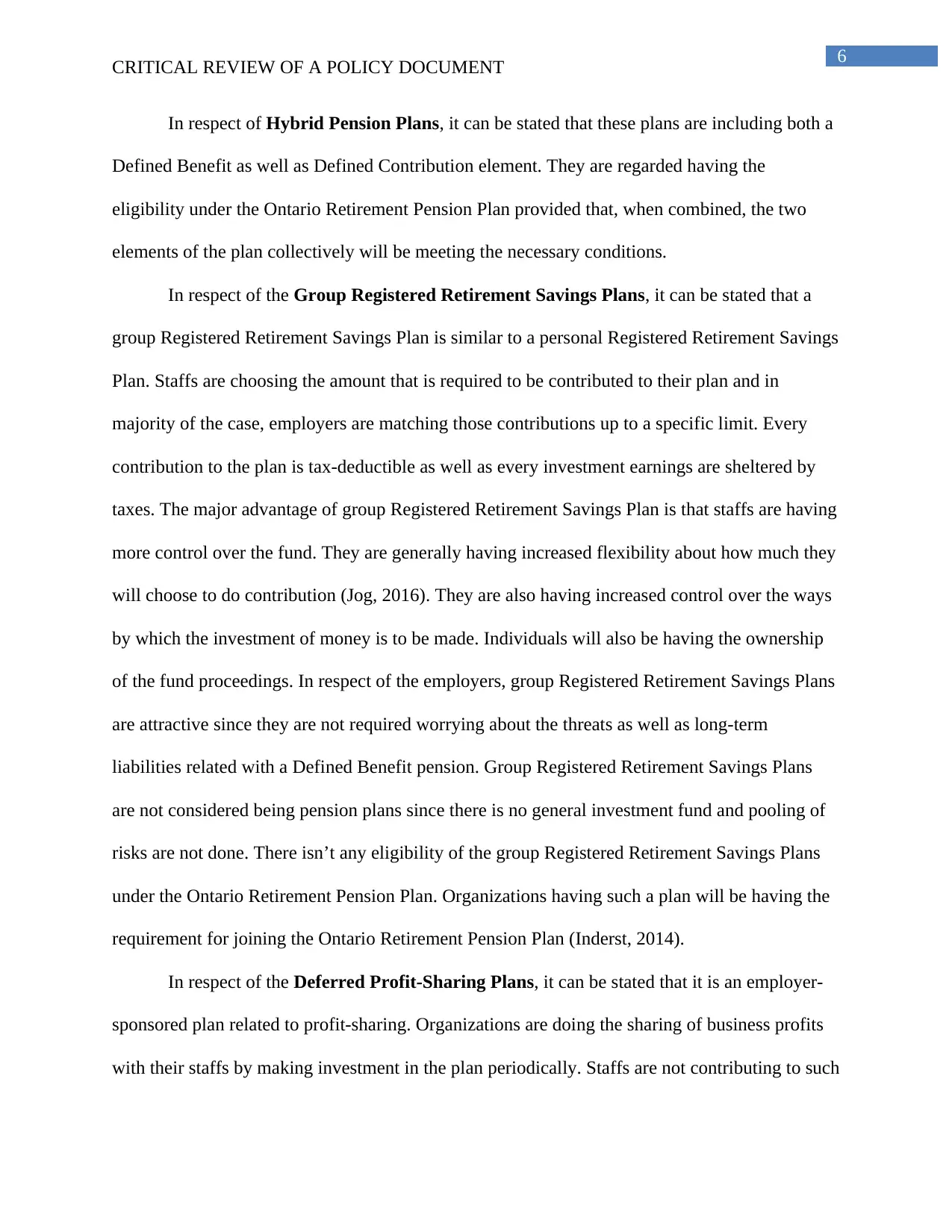
6
CRITICAL REVIEW OF A POLICY DOCUMENT
In respect of Hybrid Pension Plans, it can be stated that these plans are including both a
Defined Benefit as well as Defined Contribution element. They are regarded having the
eligibility under the Ontario Retirement Pension Plan provided that, when combined, the two
elements of the plan collectively will be meeting the necessary conditions.
In respect of the Group Registered Retirement Savings Plans, it can be stated that a
group Registered Retirement Savings Plan is similar to a personal Registered Retirement Savings
Plan. Staffs are choosing the amount that is required to be contributed to their plan and in
majority of the case, employers are matching those contributions up to a specific limit. Every
contribution to the plan is tax-deductible as well as every investment earnings are sheltered by
taxes. The major advantage of group Registered Retirement Savings Plan is that staffs are having
more control over the fund. They are generally having increased flexibility about how much they
will choose to do contribution (Jog, 2016). They are also having increased control over the ways
by which the investment of money is to be made. Individuals will also be having the ownership
of the fund proceedings. In respect of the employers, group Registered Retirement Savings Plans
are attractive since they are not required worrying about the threats as well as long-term
liabilities related with a Defined Benefit pension. Group Registered Retirement Savings Plans
are not considered being pension plans since there is no general investment fund and pooling of
risks are not done. There isn’t any eligibility of the group Registered Retirement Savings Plans
under the Ontario Retirement Pension Plan. Organizations having such a plan will be having the
requirement for joining the Ontario Retirement Pension Plan (Inderst, 2014).
In respect of the Deferred Profit-Sharing Plans, it can be stated that it is an employer-
sponsored plan related to profit-sharing. Organizations are doing the sharing of business profits
with their staffs by making investment in the plan periodically. Staffs are not contributing to such
CRITICAL REVIEW OF A POLICY DOCUMENT
In respect of Hybrid Pension Plans, it can be stated that these plans are including both a
Defined Benefit as well as Defined Contribution element. They are regarded having the
eligibility under the Ontario Retirement Pension Plan provided that, when combined, the two
elements of the plan collectively will be meeting the necessary conditions.
In respect of the Group Registered Retirement Savings Plans, it can be stated that a
group Registered Retirement Savings Plan is similar to a personal Registered Retirement Savings
Plan. Staffs are choosing the amount that is required to be contributed to their plan and in
majority of the case, employers are matching those contributions up to a specific limit. Every
contribution to the plan is tax-deductible as well as every investment earnings are sheltered by
taxes. The major advantage of group Registered Retirement Savings Plan is that staffs are having
more control over the fund. They are generally having increased flexibility about how much they
will choose to do contribution (Jog, 2016). They are also having increased control over the ways
by which the investment of money is to be made. Individuals will also be having the ownership
of the fund proceedings. In respect of the employers, group Registered Retirement Savings Plans
are attractive since they are not required worrying about the threats as well as long-term
liabilities related with a Defined Benefit pension. Group Registered Retirement Savings Plans
are not considered being pension plans since there is no general investment fund and pooling of
risks are not done. There isn’t any eligibility of the group Registered Retirement Savings Plans
under the Ontario Retirement Pension Plan. Organizations having such a plan will be having the
requirement for joining the Ontario Retirement Pension Plan (Inderst, 2014).
In respect of the Deferred Profit-Sharing Plans, it can be stated that it is an employer-
sponsored plan related to profit-sharing. Organizations are doing the sharing of business profits
with their staffs by making investment in the plan periodically. Staffs are not contributing to such
Paraphrase This Document
Need a fresh take? Get an instant paraphrase of this document with our AI Paraphraser
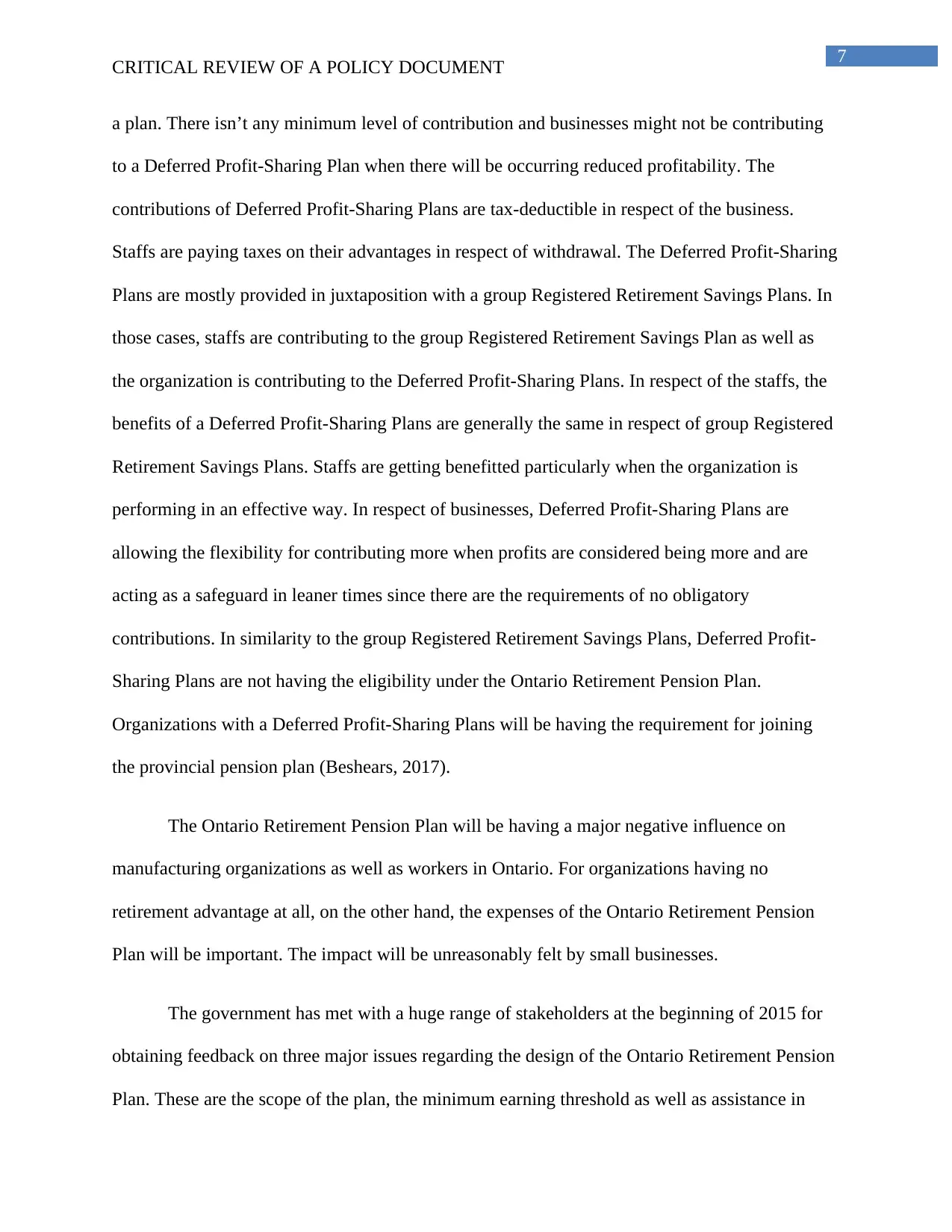
7
CRITICAL REVIEW OF A POLICY DOCUMENT
a plan. There isn’t any minimum level of contribution and businesses might not be contributing
to a Deferred Profit-Sharing Plan when there will be occurring reduced profitability. The
contributions of Deferred Profit-Sharing Plans are tax-deductible in respect of the business.
Staffs are paying taxes on their advantages in respect of withdrawal. The Deferred Profit-Sharing
Plans are mostly provided in juxtaposition with a group Registered Retirement Savings Plans. In
those cases, staffs are contributing to the group Registered Retirement Savings Plan as well as
the organization is contributing to the Deferred Profit-Sharing Plans. In respect of the staffs, the
benefits of a Deferred Profit-Sharing Plans are generally the same in respect of group Registered
Retirement Savings Plans. Staffs are getting benefitted particularly when the organization is
performing in an effective way. In respect of businesses, Deferred Profit-Sharing Plans are
allowing the flexibility for contributing more when profits are considered being more and are
acting as a safeguard in leaner times since there are the requirements of no obligatory
contributions. In similarity to the group Registered Retirement Savings Plans, Deferred Profit-
Sharing Plans are not having the eligibility under the Ontario Retirement Pension Plan.
Organizations with a Deferred Profit-Sharing Plans will be having the requirement for joining
the provincial pension plan (Beshears, 2017).
The Ontario Retirement Pension Plan will be having a major negative influence on
manufacturing organizations as well as workers in Ontario. For organizations having no
retirement advantage at all, on the other hand, the expenses of the Ontario Retirement Pension
Plan will be important. The impact will be unreasonably felt by small businesses.
The government has met with a huge range of stakeholders at the beginning of 2015 for
obtaining feedback on three major issues regarding the design of the Ontario Retirement Pension
Plan. These are the scope of the plan, the minimum earning threshold as well as assistance in
CRITICAL REVIEW OF A POLICY DOCUMENT
a plan. There isn’t any minimum level of contribution and businesses might not be contributing
to a Deferred Profit-Sharing Plan when there will be occurring reduced profitability. The
contributions of Deferred Profit-Sharing Plans are tax-deductible in respect of the business.
Staffs are paying taxes on their advantages in respect of withdrawal. The Deferred Profit-Sharing
Plans are mostly provided in juxtaposition with a group Registered Retirement Savings Plans. In
those cases, staffs are contributing to the group Registered Retirement Savings Plan as well as
the organization is contributing to the Deferred Profit-Sharing Plans. In respect of the staffs, the
benefits of a Deferred Profit-Sharing Plans are generally the same in respect of group Registered
Retirement Savings Plans. Staffs are getting benefitted particularly when the organization is
performing in an effective way. In respect of businesses, Deferred Profit-Sharing Plans are
allowing the flexibility for contributing more when profits are considered being more and are
acting as a safeguard in leaner times since there are the requirements of no obligatory
contributions. In similarity to the group Registered Retirement Savings Plans, Deferred Profit-
Sharing Plans are not having the eligibility under the Ontario Retirement Pension Plan.
Organizations with a Deferred Profit-Sharing Plans will be having the requirement for joining
the provincial pension plan (Beshears, 2017).
The Ontario Retirement Pension Plan will be having a major negative influence on
manufacturing organizations as well as workers in Ontario. For organizations having no
retirement advantage at all, on the other hand, the expenses of the Ontario Retirement Pension
Plan will be important. The impact will be unreasonably felt by small businesses.
The government has met with a huge range of stakeholders at the beginning of 2015 for
obtaining feedback on three major issues regarding the design of the Ontario Retirement Pension
Plan. These are the scope of the plan, the minimum earning threshold as well as assistance in
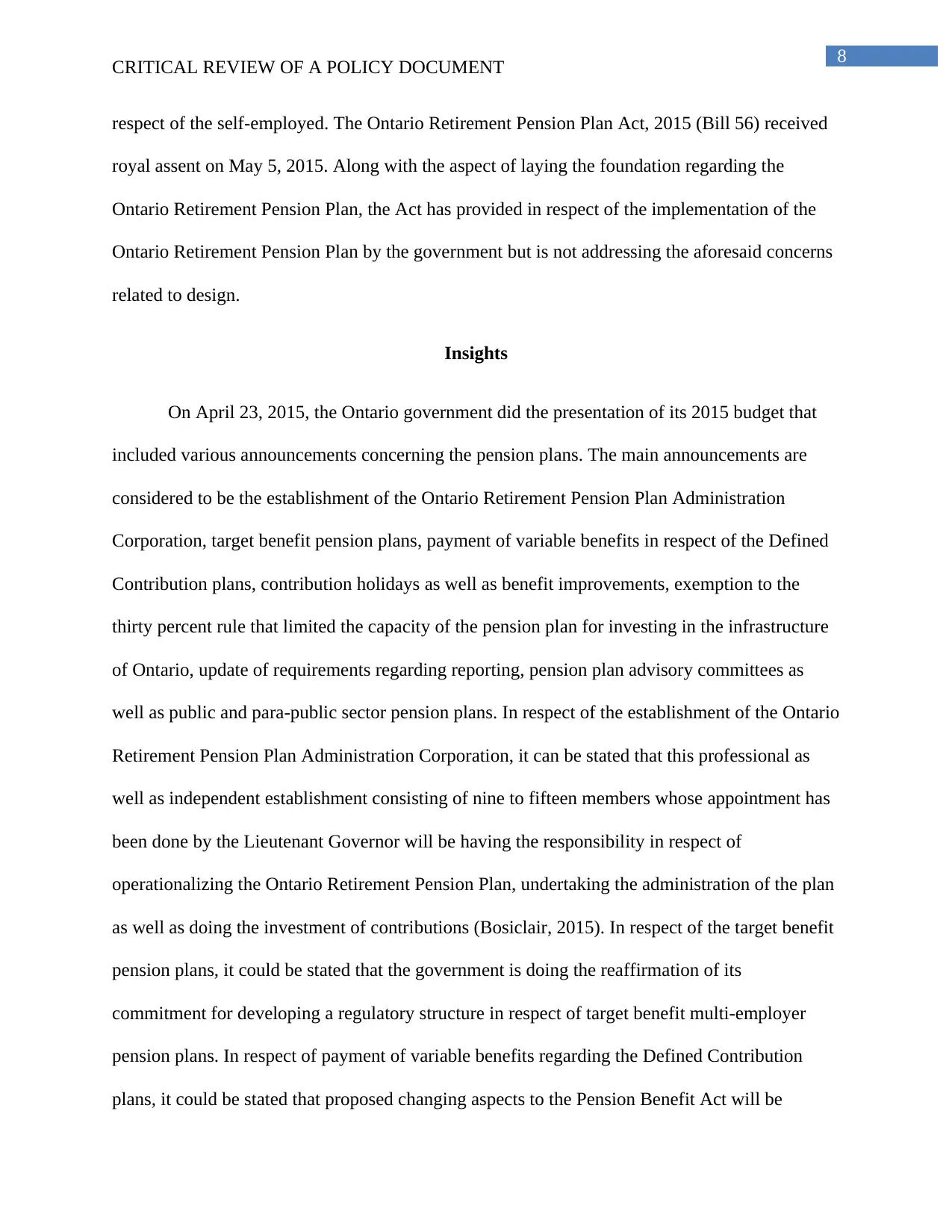
8
CRITICAL REVIEW OF A POLICY DOCUMENT
respect of the self-employed. The Ontario Retirement Pension Plan Act, 2015 (Bill 56) received
royal assent on May 5, 2015. Along with the aspect of laying the foundation regarding the
Ontario Retirement Pension Plan, the Act has provided in respect of the implementation of the
Ontario Retirement Pension Plan by the government but is not addressing the aforesaid concerns
related to design.
Insights
On April 23, 2015, the Ontario government did the presentation of its 2015 budget that
included various announcements concerning the pension plans. The main announcements are
considered to be the establishment of the Ontario Retirement Pension Plan Administration
Corporation, target benefit pension plans, payment of variable benefits in respect of the Defined
Contribution plans, contribution holidays as well as benefit improvements, exemption to the
thirty percent rule that limited the capacity of the pension plan for investing in the infrastructure
of Ontario, update of requirements regarding reporting, pension plan advisory committees as
well as public and para-public sector pension plans. In respect of the establishment of the Ontario
Retirement Pension Plan Administration Corporation, it can be stated that this professional as
well as independent establishment consisting of nine to fifteen members whose appointment has
been done by the Lieutenant Governor will be having the responsibility in respect of
operationalizing the Ontario Retirement Pension Plan, undertaking the administration of the plan
as well as doing the investment of contributions (Bosiclair, 2015). In respect of the target benefit
pension plans, it could be stated that the government is doing the reaffirmation of its
commitment for developing a regulatory structure in respect of target benefit multi-employer
pension plans. In respect of payment of variable benefits regarding the Defined Contribution
plans, it could be stated that proposed changing aspects to the Pension Benefit Act will be
CRITICAL REVIEW OF A POLICY DOCUMENT
respect of the self-employed. The Ontario Retirement Pension Plan Act, 2015 (Bill 56) received
royal assent on May 5, 2015. Along with the aspect of laying the foundation regarding the
Ontario Retirement Pension Plan, the Act has provided in respect of the implementation of the
Ontario Retirement Pension Plan by the government but is not addressing the aforesaid concerns
related to design.
Insights
On April 23, 2015, the Ontario government did the presentation of its 2015 budget that
included various announcements concerning the pension plans. The main announcements are
considered to be the establishment of the Ontario Retirement Pension Plan Administration
Corporation, target benefit pension plans, payment of variable benefits in respect of the Defined
Contribution plans, contribution holidays as well as benefit improvements, exemption to the
thirty percent rule that limited the capacity of the pension plan for investing in the infrastructure
of Ontario, update of requirements regarding reporting, pension plan advisory committees as
well as public and para-public sector pension plans. In respect of the establishment of the Ontario
Retirement Pension Plan Administration Corporation, it can be stated that this professional as
well as independent establishment consisting of nine to fifteen members whose appointment has
been done by the Lieutenant Governor will be having the responsibility in respect of
operationalizing the Ontario Retirement Pension Plan, undertaking the administration of the plan
as well as doing the investment of contributions (Bosiclair, 2015). In respect of the target benefit
pension plans, it could be stated that the government is doing the reaffirmation of its
commitment for developing a regulatory structure in respect of target benefit multi-employer
pension plans. In respect of payment of variable benefits regarding the Defined Contribution
plans, it could be stated that proposed changing aspects to the Pension Benefit Act will be
⊘ This is a preview!⊘
Do you want full access?
Subscribe today to unlock all pages.

Trusted by 1+ million students worldwide
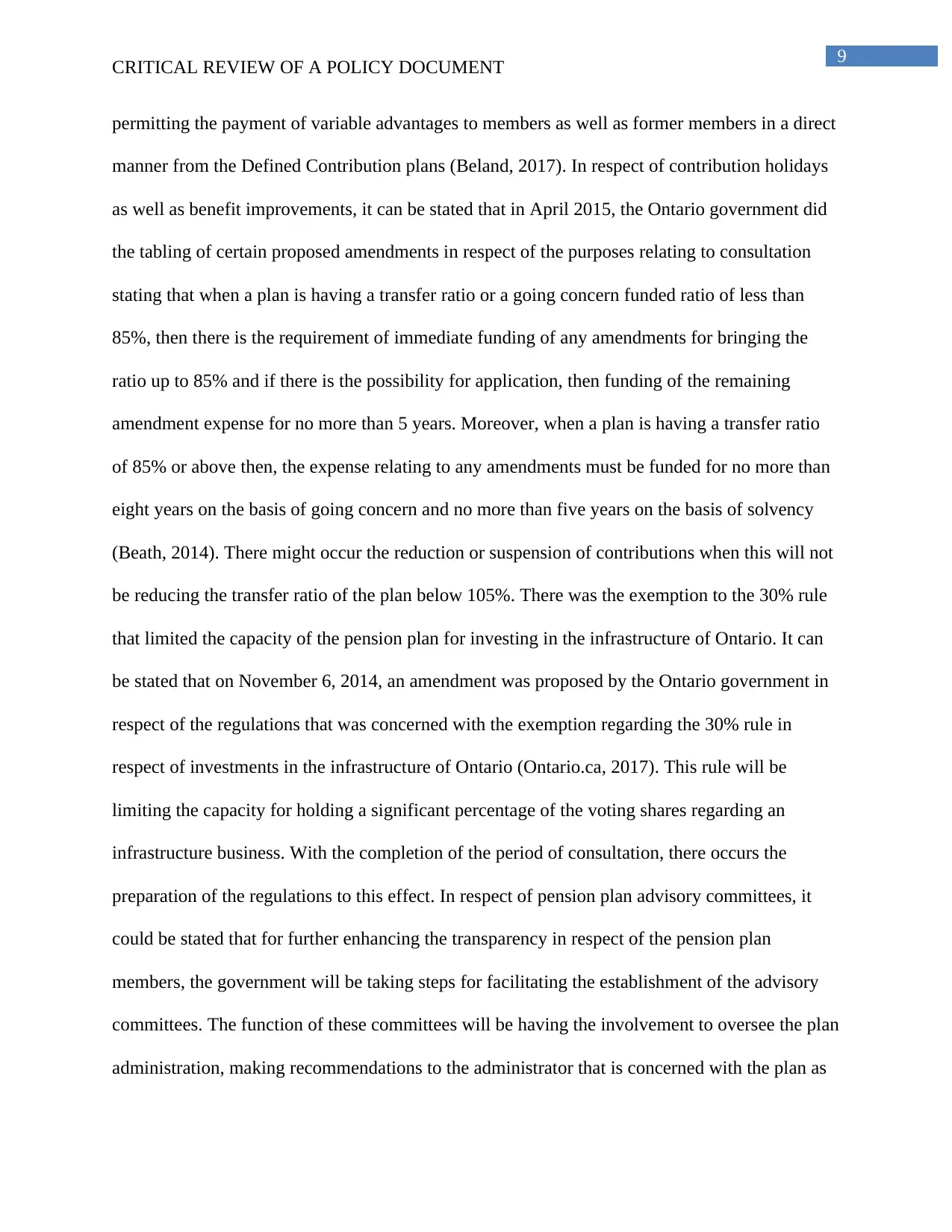
9
CRITICAL REVIEW OF A POLICY DOCUMENT
permitting the payment of variable advantages to members as well as former members in a direct
manner from the Defined Contribution plans (Beland, 2017). In respect of contribution holidays
as well as benefit improvements, it can be stated that in April 2015, the Ontario government did
the tabling of certain proposed amendments in respect of the purposes relating to consultation
stating that when a plan is having a transfer ratio or a going concern funded ratio of less than
85%, then there is the requirement of immediate funding of any amendments for bringing the
ratio up to 85% and if there is the possibility for application, then funding of the remaining
amendment expense for no more than 5 years. Moreover, when a plan is having a transfer ratio
of 85% or above then, the expense relating to any amendments must be funded for no more than
eight years on the basis of going concern and no more than five years on the basis of solvency
(Beath, 2014). There might occur the reduction or suspension of contributions when this will not
be reducing the transfer ratio of the plan below 105%. There was the exemption to the 30% rule
that limited the capacity of the pension plan for investing in the infrastructure of Ontario. It can
be stated that on November 6, 2014, an amendment was proposed by the Ontario government in
respect of the regulations that was concerned with the exemption regarding the 30% rule in
respect of investments in the infrastructure of Ontario (Ontario.ca, 2017). This rule will be
limiting the capacity for holding a significant percentage of the voting shares regarding an
infrastructure business. With the completion of the period of consultation, there occurs the
preparation of the regulations to this effect. In respect of pension plan advisory committees, it
could be stated that for further enhancing the transparency in respect of the pension plan
members, the government will be taking steps for facilitating the establishment of the advisory
committees. The function of these committees will be having the involvement to oversee the plan
administration, making recommendations to the administrator that is concerned with the plan as
CRITICAL REVIEW OF A POLICY DOCUMENT
permitting the payment of variable advantages to members as well as former members in a direct
manner from the Defined Contribution plans (Beland, 2017). In respect of contribution holidays
as well as benefit improvements, it can be stated that in April 2015, the Ontario government did
the tabling of certain proposed amendments in respect of the purposes relating to consultation
stating that when a plan is having a transfer ratio or a going concern funded ratio of less than
85%, then there is the requirement of immediate funding of any amendments for bringing the
ratio up to 85% and if there is the possibility for application, then funding of the remaining
amendment expense for no more than 5 years. Moreover, when a plan is having a transfer ratio
of 85% or above then, the expense relating to any amendments must be funded for no more than
eight years on the basis of going concern and no more than five years on the basis of solvency
(Beath, 2014). There might occur the reduction or suspension of contributions when this will not
be reducing the transfer ratio of the plan below 105%. There was the exemption to the 30% rule
that limited the capacity of the pension plan for investing in the infrastructure of Ontario. It can
be stated that on November 6, 2014, an amendment was proposed by the Ontario government in
respect of the regulations that was concerned with the exemption regarding the 30% rule in
respect of investments in the infrastructure of Ontario (Ontario.ca, 2017). This rule will be
limiting the capacity for holding a significant percentage of the voting shares regarding an
infrastructure business. With the completion of the period of consultation, there occurs the
preparation of the regulations to this effect. In respect of pension plan advisory committees, it
could be stated that for further enhancing the transparency in respect of the pension plan
members, the government will be taking steps for facilitating the establishment of the advisory
committees. The function of these committees will be having the involvement to oversee the plan
administration, making recommendations to the administrator that is concerned with the plan as
Paraphrase This Document
Need a fresh take? Get an instant paraphrase of this document with our AI Paraphraser
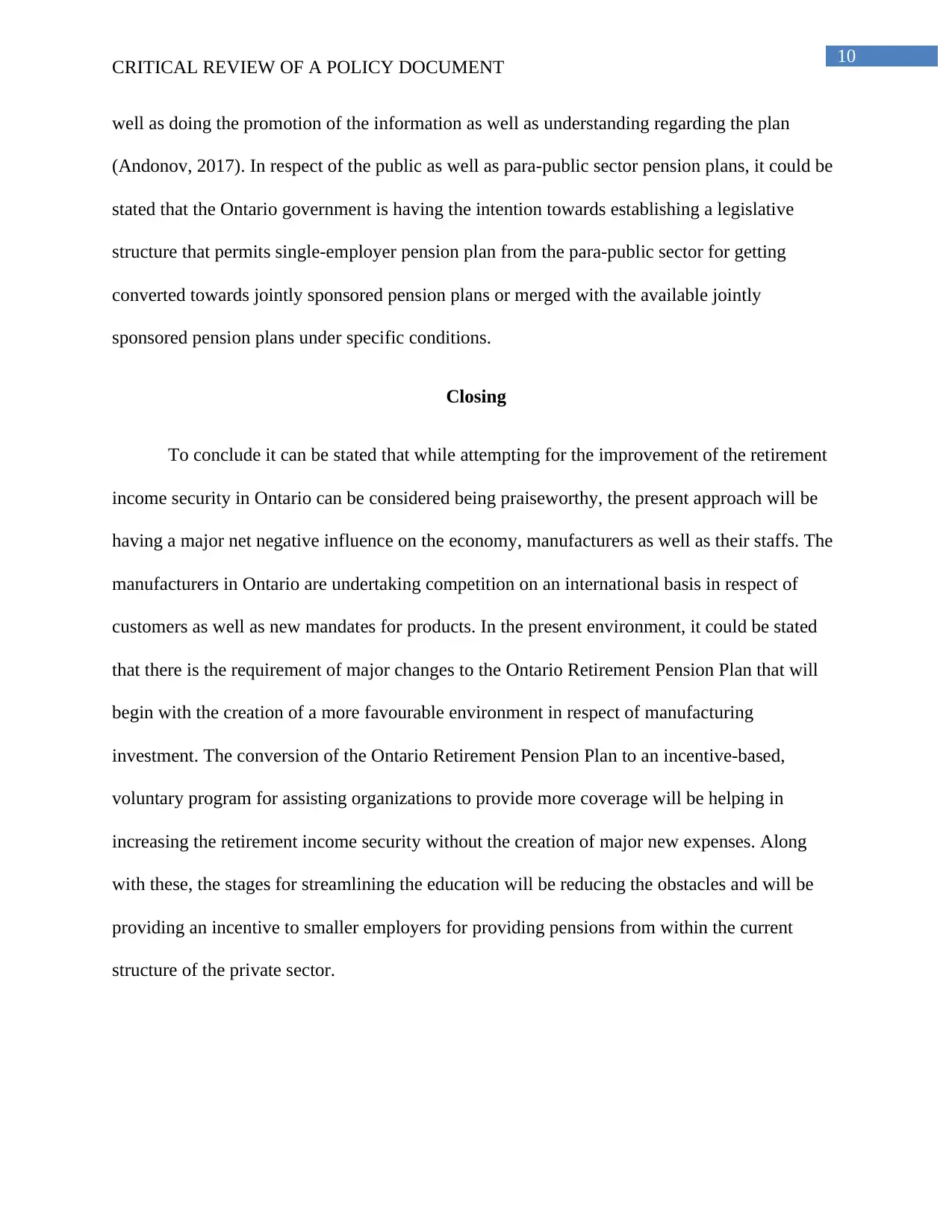
10
CRITICAL REVIEW OF A POLICY DOCUMENT
well as doing the promotion of the information as well as understanding regarding the plan
(Andonov, 2017). In respect of the public as well as para-public sector pension plans, it could be
stated that the Ontario government is having the intention towards establishing a legislative
structure that permits single-employer pension plan from the para-public sector for getting
converted towards jointly sponsored pension plans or merged with the available jointly
sponsored pension plans under specific conditions.
Closing
To conclude it can be stated that while attempting for the improvement of the retirement
income security in Ontario can be considered being praiseworthy, the present approach will be
having a major net negative influence on the economy, manufacturers as well as their staffs. The
manufacturers in Ontario are undertaking competition on an international basis in respect of
customers as well as new mandates for products. In the present environment, it could be stated
that there is the requirement of major changes to the Ontario Retirement Pension Plan that will
begin with the creation of a more favourable environment in respect of manufacturing
investment. The conversion of the Ontario Retirement Pension Plan to an incentive-based,
voluntary program for assisting organizations to provide more coverage will be helping in
increasing the retirement income security without the creation of major new expenses. Along
with these, the stages for streamlining the education will be reducing the obstacles and will be
providing an incentive to smaller employers for providing pensions from within the current
structure of the private sector.
CRITICAL REVIEW OF A POLICY DOCUMENT
well as doing the promotion of the information as well as understanding regarding the plan
(Andonov, 2017). In respect of the public as well as para-public sector pension plans, it could be
stated that the Ontario government is having the intention towards establishing a legislative
structure that permits single-employer pension plan from the para-public sector for getting
converted towards jointly sponsored pension plans or merged with the available jointly
sponsored pension plans under specific conditions.
Closing
To conclude it can be stated that while attempting for the improvement of the retirement
income security in Ontario can be considered being praiseworthy, the present approach will be
having a major net negative influence on the economy, manufacturers as well as their staffs. The
manufacturers in Ontario are undertaking competition on an international basis in respect of
customers as well as new mandates for products. In the present environment, it could be stated
that there is the requirement of major changes to the Ontario Retirement Pension Plan that will
begin with the creation of a more favourable environment in respect of manufacturing
investment. The conversion of the Ontario Retirement Pension Plan to an incentive-based,
voluntary program for assisting organizations to provide more coverage will be helping in
increasing the retirement income security without the creation of major new expenses. Along
with these, the stages for streamlining the education will be reducing the obstacles and will be
providing an incentive to smaller employers for providing pensions from within the current
structure of the private sector.
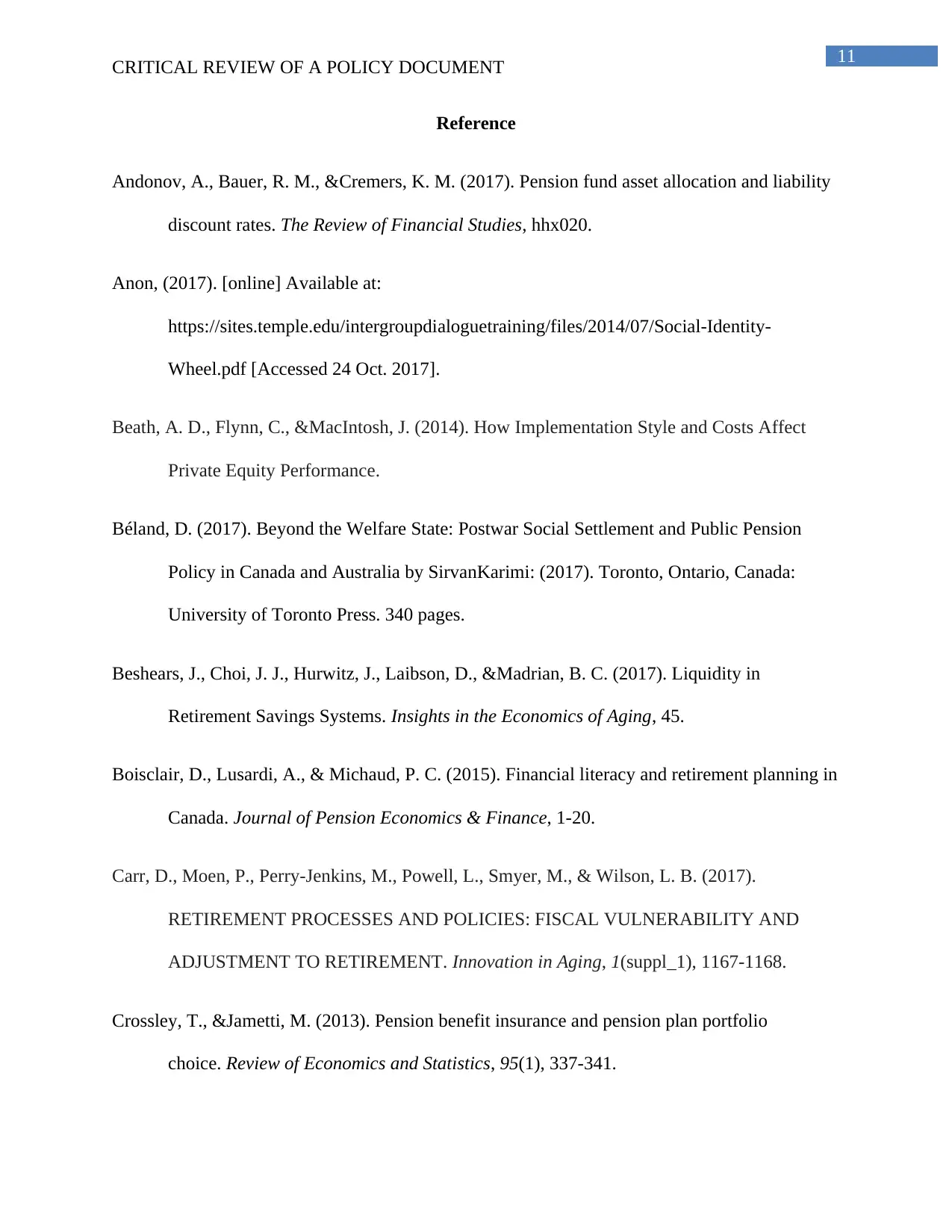
11
CRITICAL REVIEW OF A POLICY DOCUMENT
Reference
Andonov, A., Bauer, R. M., &Cremers, K. M. (2017). Pension fund asset allocation and liability
discount rates. The Review of Financial Studies, hhx020.
Anon, (2017). [online] Available at:
https://sites.temple.edu/intergroupdialoguetraining/files/2014/07/Social-Identity-
Wheel.pdf [Accessed 24 Oct. 2017].
Beath, A. D., Flynn, C., &MacIntosh, J. (2014). How Implementation Style and Costs Affect
Private Equity Performance.
Béland, D. (2017). Beyond the Welfare State: Postwar Social Settlement and Public Pension
Policy in Canada and Australia by SirvanKarimi: (2017). Toronto, Ontario, Canada:
University of Toronto Press. 340 pages.
Beshears, J., Choi, J. J., Hurwitz, J., Laibson, D., &Madrian, B. C. (2017). Liquidity in
Retirement Savings Systems. Insights in the Economics of Aging, 45.
Boisclair, D., Lusardi, A., & Michaud, P. C. (2015). Financial literacy and retirement planning in
Canada. Journal of Pension Economics & Finance, 1-20.
Carr, D., Moen, P., Perry-Jenkins, M., Powell, L., Smyer, M., & Wilson, L. B. (2017).
RETIREMENT PROCESSES AND POLICIES: FISCAL VULNERABILITY AND
ADJUSTMENT TO RETIREMENT. Innovation in Aging, 1(suppl_1), 1167-1168.
Crossley, T., &Jametti, M. (2013). Pension benefit insurance and pension plan portfolio
choice. Review of Economics and Statistics, 95(1), 337-341.
CRITICAL REVIEW OF A POLICY DOCUMENT
Reference
Andonov, A., Bauer, R. M., &Cremers, K. M. (2017). Pension fund asset allocation and liability
discount rates. The Review of Financial Studies, hhx020.
Anon, (2017). [online] Available at:
https://sites.temple.edu/intergroupdialoguetraining/files/2014/07/Social-Identity-
Wheel.pdf [Accessed 24 Oct. 2017].
Beath, A. D., Flynn, C., &MacIntosh, J. (2014). How Implementation Style and Costs Affect
Private Equity Performance.
Béland, D. (2017). Beyond the Welfare State: Postwar Social Settlement and Public Pension
Policy in Canada and Australia by SirvanKarimi: (2017). Toronto, Ontario, Canada:
University of Toronto Press. 340 pages.
Beshears, J., Choi, J. J., Hurwitz, J., Laibson, D., &Madrian, B. C. (2017). Liquidity in
Retirement Savings Systems. Insights in the Economics of Aging, 45.
Boisclair, D., Lusardi, A., & Michaud, P. C. (2015). Financial literacy and retirement planning in
Canada. Journal of Pension Economics & Finance, 1-20.
Carr, D., Moen, P., Perry-Jenkins, M., Powell, L., Smyer, M., & Wilson, L. B. (2017).
RETIREMENT PROCESSES AND POLICIES: FISCAL VULNERABILITY AND
ADJUSTMENT TO RETIREMENT. Innovation in Aging, 1(suppl_1), 1167-1168.
Crossley, T., &Jametti, M. (2013). Pension benefit insurance and pension plan portfolio
choice. Review of Economics and Statistics, 95(1), 337-341.
⊘ This is a preview!⊘
Do you want full access?
Subscribe today to unlock all pages.

Trusted by 1+ million students worldwide
1 out of 14
Related Documents
Your All-in-One AI-Powered Toolkit for Academic Success.
+13062052269
info@desklib.com
Available 24*7 on WhatsApp / Email
![[object Object]](/_next/static/media/star-bottom.7253800d.svg)
Unlock your academic potential
Copyright © 2020–2025 A2Z Services. All Rights Reserved. Developed and managed by ZUCOL.



